Review Philips 855

Philips 855, live pictures
Package :
-
Handset
-
Charger
-
User's manual
-
Stereo headset

Philips was the first among phone manufacturers who introduced clamshell mobile phone that can open at 180 degrees scale, the model's index is 855. For the first time such phone was semi-officially announced by Sagem about 1.5 years ago (model X8), all this time the engineers were trying to work out phone's construction. The main problem for such devices is slipping contact, which is located in hinge, which is connecting the two parts. This was the main reason why Sagem was unable to release this model in time. At the same time Philips without any unnecessary hesitation prepared this model and in the end became the first manufacturer who offers this hybrid device. Philips phone successfully combines all advantages of such construction (small size in closed mode, fashion part), as well as advantages of ordinary phones I (straight, even construction, no corner, unlike other clamshells). It turns out that the company has expanded potential range of consumers for its product, this can be not only classic lovers, but fashion fans as well. For second ones this phone will become a true goodie, there are no analogues around, at all!

The technical part is based on the existing platform from Philips, it is similar in many aspects with the previous models. Surprisingly the company managed to match both, design and software part of the phone. In this model a lot of existing features received their logical evolutional development. But let's review everything in order, shall we?
The phone has traditional size for its segment (85x47x25 mm) as well as weight (86 grams, manufacturer mentioned 91 grams), the phone's advantage is the fact that antenna is built-in. After you open the phone you will notice that its length is more than most classical models have (162 mm). The microphone is located closer to your mouth, which is a certain advantage.

The phone's upper butt-end is splay, meanwhile the lower part is rounded. You will encounter impression of unusual design, the phone has his own look. You can see the VGA-camera on the front panel, its mirror is not present, as well as external screen surrounded by edging which color is different.

During the stand by mode screensaver presented in look of clock will get activated (bright digits at black background), you can activate the display by pressing side volume control keys. The phone uses cSTN display that can display up to 4096 colors. Its resolution is (96x64 pixels, 20x14 mm) this allows showing one text line (phone number will fit to the line completely), as well as displaying status line (battery level, network reception).


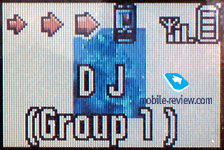
From the utilitarian point of view the screen is not very good when it hits direct sunlight, it turns pale instantly and its worth is dropping instantly as well. Whenever there is an incoming call around, the screen will display the caller's phone number for some seconds and in the end its backlight will turn off. In order to see who's calling you (not everyone is capable of picking up the phone right after it starts ringing) – you just have to open the clamshell, or press the side key. Whenever you perform this operation the ring tone will automatically turn off and the external display will be activated. Such difficult and ambiguous at first sight procedure is related to the phone's construction and will of creating lower energy consuming rate. Whenever external display's backlight gets activated, note that internal display and the keyboard's backlight will turn on as well. It's obvious that this leads to higher energy consuming. This is why such strange way of external display's backlight was introduced.
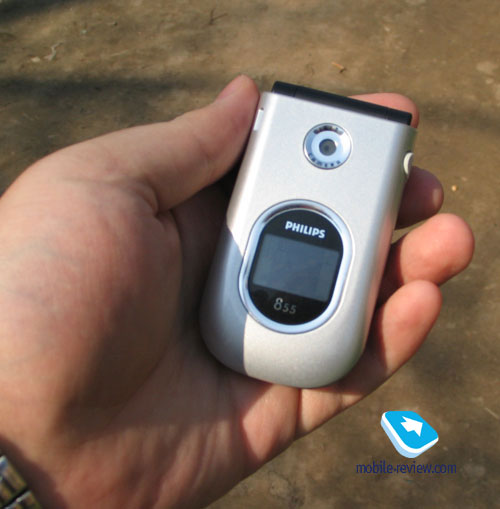
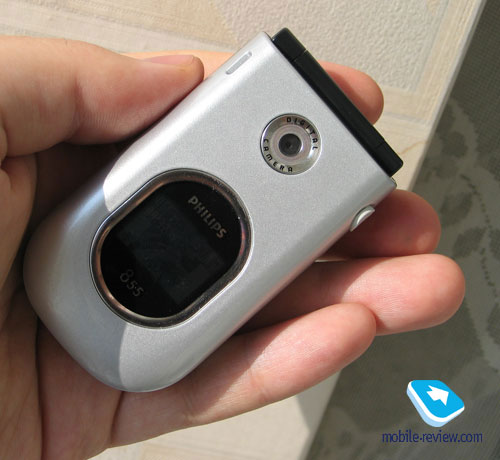
One of the advantages that are unique for phones that have external color displays is ability to bind wallpapers for them, it can be any type of image, preinstalled picture or your photo. Big images get scaled in order to fit the screen's size and resolution and they do not fill it up completely all the time. There are about 10 pictures that are optimized for the external display's wallpaper size shipped inside every phone. In any case you are free to disable this feature.
I'd like to say that the user can bind his own images to caller's groups in the phone book, in this case whenever there is an incoming call on the horizon – you will see corresponding picture being displayed. Binding custom pictures to single contacts is impossible.
You can see the port for connecting the headset on the right side, other port is used for charger correspondingly. The IrDA window is located in the very bottom. In this model IrDA is fully functional, with its help you can send and receive ring tones and pictures. For example sending and receiving pictures from and to P900 did not cause any difficulties, all that was required – was activating the IrDA on both phones.
The hole for strap is located on the right edge. Taking in mind the phone's construction I can say that the use of strap is not advisable, in this case it will often lean between the two sides, and this will cause the phone not being fully opened.
On the left side there is another hole, this is additional speaker, it is used for ring tone playback.

It is easy to open the phone with one hand, it fits nicely into one's palm. Inside you will see big screen that is capable of displaying up to 65 000 colors, it is made by TFT technology (128x160 pixels, 32x38 mm). The display's quality is not as high as ones installed in Samsung or Motorola phones, but it can still be competitive with other manufacturers. The picture is not saturated enough, but it remains sharp and contrast. This creates good combination of style and functionality, the phone's interface created for it is nicely drawn. Seems that here the developers knew what they were doing when they had decided to draw icons not so detailed, by this they have achieved better outlook of everyday menu. I mean really, how often are we glancing at cute pictures in the phone's display? How often are we using the menu?
In order to make justice back to normal I will have to point out that the pictures from the built-in camera are looking very nice when they are viewed at the phone's screen. Here the fact that built-in cameras do not give oversaturated, vivid colors plays important role. The picture is sharp, clear – this is its main parameters.
The screen's size can contain up to 7 text lines (sms viewing) and up to 2 text lines for service needs.
The display turns rather pale when it hits direct sunlight, but it is typical for any display even from other manufacturers.

Let's move on to the phone's keyboard, it is made of plastic which reminds rubber. The alike material was used in Motorola E398's case, as well as back cover of Ericsson T68 (in T68i the plastic was casual).
The key's size is big enough, keypad is made in one block factor, iridescent wave (furrow between rows). There is separate key for straight access to the camera, Call and End Call keys are playing the role of corresponding soft-keys. The four-positional navigational key is located in the middle, OK button is inscribed in it. For the first time among recent models from various phone manufacturers I was using a phone with good keyboard's ergonomics, it deserves separate praise. Working with phone thanks to convenient button placing turns out to be a pleasure. The button's material, that they are made of, increases this feeling even more. The key's stroke is rather small, tight and pleasant. On the whole dithyrambs to keyboard can be sing during long terms, although it does not have anything peculiar. It's just that among those refinement keyboards that are produced by other manufacturers, an ordinary classical keyboard with small enhancements seems being manna from heaven. If you ask me – these experiments with keyboards are good only in certain, limited range.
The back surface has cover that is hiding battery under itself. You just have to pull it down and it will jump out from grooves. The simplicity of construction does not mean that it is proof. The backlash is not present, this is a huge plus.

The phone uses Li-Ion battery with 600 mAh capacity. The manufacturer claims that it can work up to 300 hours in stand by mode and up to 6 hours during the conversations. Philips is known for its great performance in terms of energy saving, but this is not related to this model; miracles happen too seldom, and this time was not one of those. High performance should be related to one of marketing's tricks, which does not wish or just cannot admit that the model line-up because of physics laws cannot work for too long (two color screens are ones to blame). That's why the phone works for about same time as its competitors, the average working time from one battery charge was 3 days. During this time we managed to speak for about 30 minutes and use phone up to 30 minutes in games and other functions. It takes slightly more than 1.5 hours for the battery to charge up completely.
SIM-card holder is standard, it does not have anything interesting beyond it.

Menu
In terms of interface the phone is logical successor of Philip's line-up, here you see the very same roundabout menu, standard set of features. But to my surprise new set of icons was noticed, instead of existing ones, a lot of icons were redrawn in order to match the screen's specifications, this only brings joy. Fast launch of applications by leaning the navigational key (alike phones from Motorola) was added. The main difference of this function is that when you are activating it those menu items that were bind to it will be always shown on the screen, you cannot remove it. The second disadvantage is that you cannot create custom menu items, this is always creation of MMS-messages, access to the phone book, recent calls and SMS-sending. We can say that this is newly introduced feature that will later on be expanded and improved, in any case this is significant and notable move by Philips.
 

You can set any type of image as wallpaper, it will be shown not only in stand by mode, but in all menus as well. This brings in certain limitations, in case you had chosen wrong image some menu icons and signatures for them will be hardly readable. Similar problem is seen in Nokia 6230, but here it is not so actual and bad, the bigger screen's resolution and icons as well as signatures for them is the answer why.
Other improvements are minor ones, they just make the working process easier and pleasanter., this sometimes turns out surprising. From now on you can see where this or that selection in the menu will lead to. For example when you are choosing the type of clock for screen (analogue, digital and mixed) you will instantly see the way how they look right in the list. Same thing is related to other menu items.
When you are dialing the number digits are big and nicely determinable. But there is a fly in the ointment. The phone kept traditional problems, some menu items are tangled because of roundabout menu structure, access to them is rather hard. The lack of fast number navigation cannot be considered as advantage. The unprepared user will be using navigational key all the time, the fact that it is convenient saves the day. On the whole I should point out that the menu's ergonomics and its perception is better than in previous models. Let's review all phone's features in order, shall we?
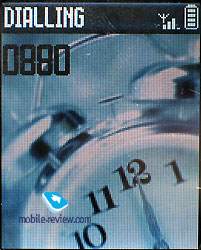 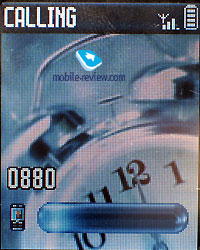
 
The interface is typical for Philips' phones- the main menu is a row of animated icons, you can navigate the menu with the joystick. To get one level up - press C button. If you try to quit the menu with the red button like you're used to do in other phones - nothing will happen. There is no fast navigation with the help of number chains. But you can bind 8 shortcuts to different menu items to the buttons. For example - if you press 5 during standby mode you will start the Calculator.
The new function which is typical only for this phone is ability to turn on 4 shortcuts for fast access (four sides of the navigational key). In this mode you will always see corresponding menu items on the screen, but you cannot change their order or the items themselves.
Almost all sub-menus are represented as icons formed in a circle. If you use functions that are hidden down deep in the menu structure, you will have to work that joystick a lot OR start them with voice activation. Yep, the phone's memory can store up to 40 voice commands which can be used for accessing features that are used the most. Navigating the menu will become a lot easier and faster - you'll just have to get used to the Voice Command feature.
Phone book. Up to 499 contacts can be saved in the phone's memory, for each you can define name, surname, note, up to 5 phone numbers and one e-mail address. The phone book can be accessed from the stand by mode by pressing down the navigational key. Only one phone book (either from phone or from SIM-card) can be displayed at once. Only names and Surnames are displayed in the list; in case if the record does not fit into the screen it will be automatically scrolled. While an entry is marked a telephone-like icon will be shown on the right. Even if there are no any, the arrows near the icon will remain active. The first number that will be displayed in the list is the one which was first entered in the phone's memory, this releases you from ceessity of binding default numbers separately. In order to dial the chosen number you just have to press Call button. If you need to find out what number is stored under this or that name – you will have to scroll the menu. This operation is required if you want to bind separate number a voice tag (up to 40), the recognition works good, except for the moment that you can bind one and the same word on different number. In this case the phone will always bring up the contact which was bind last, the first one will never be activated, but stored in memory.
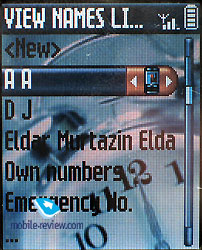 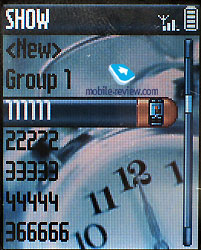

Phonebook supports first letter search, but in order to search again you have to hit at least one name after your first search. This flaw is caused because a name can be searched by entering several letters, for example Smith can be found by 7 (pqrS) or 6 (Mno) and 4 (ghI). A second variant would be more preferable if you have a lot of names in your Phonebook.
You can set melodies and pictures (Photo Call) for 50 groups in the Phonebook. In future they will be used whenever there is an incoming call on the horizon.
Messages. Here you can read incoming messages and compose your own. When you're listing messages - they will be shown in full-length with the help of a preview line. And when you are selecting a message it will automatically scroll into full-screen mode. It's something new that we don't see everyday, and it's actually quite handy. 10 templates are already composed, which is more or less a standard in a mobile phone these times. You can add one or more funny icons or sounds for EMS messages if you like.
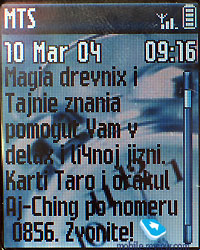 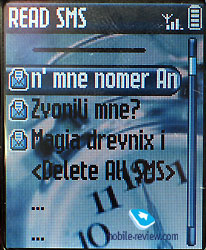
The pictures for EMS-messages are extremely interesting, they are rather varied and are drawn with humor.
Messages can be stored into an archive, you can also set outgoing messages to move automatically into Saved Messages folder if you want to.
The built-in e-mail client functions with typical mail accounts (max. 2) based on POP3/SMTP protocols. The phone can receive and send mail through a GPRS connection, but it doesn't support attachments (except jpg). Messages bigger than 10kb will be automatically denied. Settings. Everything is simple here, you have a security level setup, ability to choose one of five available themes for display, define backlight's working cycle (up to 1 minute), setup screensaver etc.
 
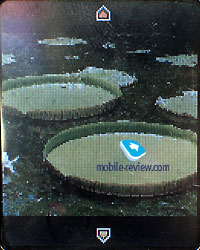 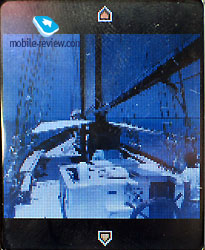
 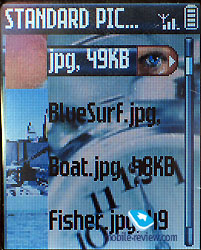
All audio settings are located here as well: volume setup, vibrating alert, mixed mode. And last, but not the least - five settings for equalizer which are used when talking on the phone. They were possible with the help of ARM codecs. The only problem is that this feature must be supported by your operator. I've tried changing the settings, but everything remained the same because my operator didn't support this feature at this time.
Philips 855 supports profiles, but all of them except one are locked and can only be used the way they are pre-installed, no settings can be changed. Only the custom profile can be changed according to your needs so it turns out that the phone has only one true profile.
Multimedia.
Several functions are located in this menu, here is a short description of each.
Picture Album. A list of pictures in the phone, and there are quite a lot pictures pre-installed. Most of them are pictures of animals and children. All pictures are stored in jpg format which is supported by the phone. You can see all pictures or choose one for background. One of the most interesting features is that you can easily create screensavers, using only one or a number of pictures. You can also see icons that are used for EMS messages.
Sound Album. Well, as in the previous case the title speaks for itself, here you can find melodies and records made with the voice memo feature, both can be used as ringtones or reminders.
Dictaphone. You can store various amount of records in the phone's memory (up to 20), the Dictaphone can work in both stand by and conversation modes (both sides). The length of record depends on the amount of free memory, but it cannot exceed length of one minute.

Memory Counter. Displays free/allocated memory stats of the phone, which is very useful because it shows how many percent is used by every application. Besides, you can also pick a specific application and see how much records and memory it uses. This handset has 8045 Kb for memory, with about 450 Kb already used by java and files.
 
Games and Applications. Various useful functions are located here, an alarm clock for example. Recurrence can be set as well, including an "only during weekdays" option.
The calculator has basic functions, nothing extraordinary.

The brick game (Arkanoid-type) is quite simple and is the only one in the phone that is not a Java-game.

The phone supports Java applications (MIDP 1.0), there are some games already installed including helicopter fight and logical game, in which you have to form row from three equal pictures, it is pretty good.
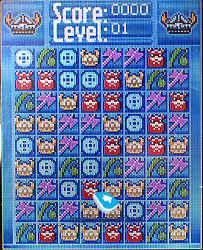 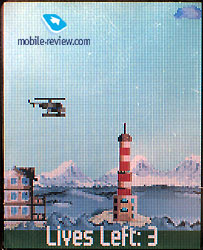
Organiser. As the title so cunningly may reveal - this menu item stands for the Organiser. You can see a Calendar (for a week or a month). While looking at the month mode in the Calendar some events arranged are marked out. And when you are looking in week mode you can see special icon near every day that has an event planned. There are three types of events: meeting, relaxation and business. For every record a date of beginning and end can be set. They can also be set at several intervals (a day, a week, a month and a year), you can also set a reminder-time to start warning you about the event. There is also a function that allows you to delete all old events at once, which I find very useful. On the whole - the Organiser works fine, nothing special though. The memory of Phonebook and Organiser are combined and shared dynamically. A little surprise: you can record 499 Phonebook entries only if there are no entries stored in the Organiser. You cannot store more than 499 contacts/events.
 
 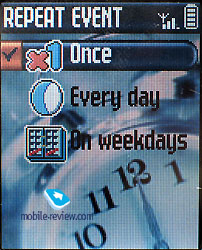
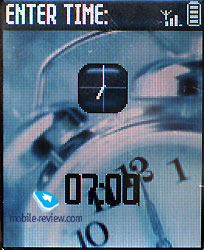 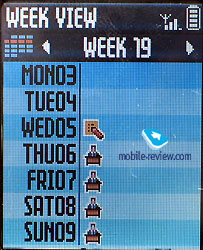
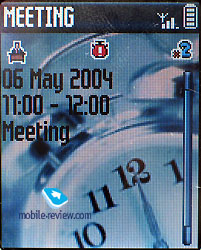 

Call list. List of calls, it's common, meaning that the last 30 missed, dialed and received calls are listed in this menu. You can look up the date and time of each call. They can be seen if you press the joystick up once. The numbers can be used the same way as in the Phonebook (messages, details etc.). The calls to one and the same number are not taken into consideration, they are shown one after another, for most users such realization is not entirely convenient.
Operator Services. The WAP browser can be accessed from here. Nothing special, the phone has GPRS (4+2) and it works fine.
Camera. This model has built-in VGA-camera, its interface has survived several improvements and new features. First of all, from now on you can choose either portrait or landscape mode for the internal screen. The supported resolutions are called VGA, Wallpaper, CLIP, Fotocall. The advantage of such titles is that user sees what they can be used for at once. There are three levels of JPEG file compression available, this directly affects the picture quality (low, average, high). During the shooting you can instantly setup this or that frame, but this can be and should be done after the picture is made, in a separate graphic editor. It allows not only using the frame, but add simple pictures from the set to a photo, make some changes to parts of picture. The function of graphical editor will be used by young users.
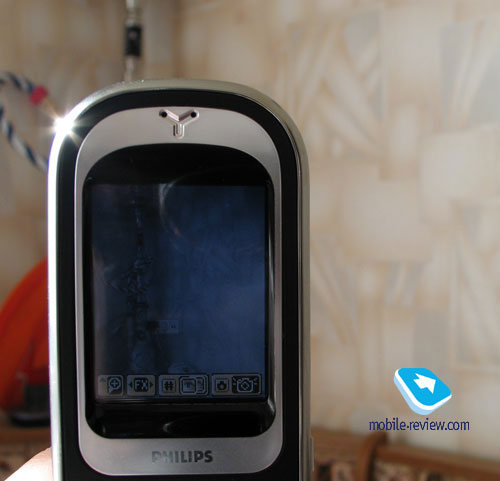

 
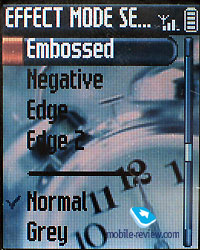 
 
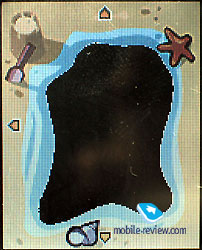
The user can use various effects for photos (Grey, Sepia, Digital, Embossed, Negative, Edge, Edge2).
There is also night-mode in it the picture is not always good, you can see certain grain/noise. You should take pictures in automatic mode, the quality is mostly better. Traditionally you can find timer for self-shooting, here it works even if the phone is closed.
There is no video recording function in this model, but there is a sort of intermediate solution. You can create picture and at once record up to 30 seconds of sound, and later on send it with message. I cannot tell you if this function is really necessary.
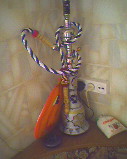 
 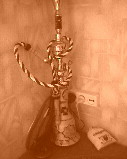
Photos examples (270 Kb , ZIP)
TV-Link.
In the phone's menu you can find function of slide-show from media-album, you just have to setup corresponding time interval. In reality this feature is used with separate accessory which is connected to phone and TV (standard connector). The quality of picture on the TV is higher than expected, but we cannot say that it is photographical. On the whole this accessory is just a part of praise to fashion and does not contain any value for user.

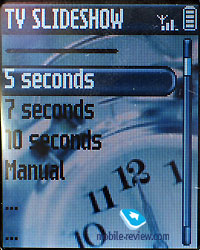 
ImpressionsThe phone's network reception quality does not raise any problems, it provides stable connection. One of the advantages is the fact that you will hear small noises during your talks, these noises are continuous. Similar noises are present in many models from Samsung, that's why we will not say that this parameter is critical for users. However before using this phone you should find out about it more and closer, call to another phone as well.
The polyphonic ring tone's volume is average, I cannot say that it is too loud. At the same time set of installed ring tones is nice. The ring tones are usually heard on the street, but if you put it inside your jeans pocket, you better activate vibrating alert as well. Here the vibrating alert profile is as follows, the phone is felt by small tremble. I cannot say that the vibrating alert power is strong or significant, but you will feel it.
Thanks to the design and materials used in the phone's construction the phone leaves very nice impression. Philips brand fans will be pleased, this is the ideal product for them today. Others should look at this product as well, it is extremely interesting. At the moment its competitors are Alcatel 835, and not-yet announced model from Sagem (X8 successor). Other phones have similar functionality, but bring different ideology, their direct comparing should not be done.
Philips 855 should be expected in the middle of July with 330 dollar price. During the upcoming months the price will be around 275 dollars, from this time the model's price seems to be correct. At the same time you can buy the phone even for 330 dollars, because of its unique design. As a result the interest to this fashion solution will be comparably high. We cannot say that this model will become top sale, but it will have stable sales, and this is a seldom thing during our saturated market's segment.
Eldar Murtazin ([email protected])
Translated by Alexander "Lexx" Zavoloka([email protected])
Published — 18 May 2004 |






























































